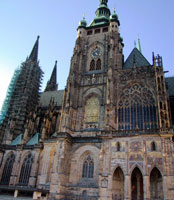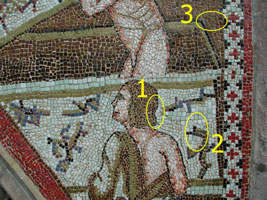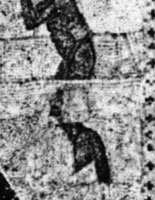
This issue in pdf Archive: Next issue: Next Special theme: |
|
|||||||
Digital Image Processing in Art Conservationby Barbara Zitová and Jan Flusser Part of the 'Last Judgement' Mosaic conservation project has employed up-to-date image processing techniques to enhance an old photograph of the mosaic, and in particular to compare the current state of the mosaic with its condition in the nineteenth century. This work was done by the Institute of Information Theory and Automation at the Academy of Sciences of the Czech Republic, along with the Getty Institute, U.S.A. and the Prague Castle Administration. In 1992-2000, the Getty Institute (Los Angeles, CA), jointly with specialists from the Czech Republic, realised The Last Judgement Mosaic conservation project. The mosaic, which is 84 square metres in area, was created in 1371 and is situated on the outer wall of the St.Vitus Cathedral in Prague, in the Czech Republic (see Figure 1). The dilapidation of the mosaic during the centuries was very severe, due to high levels of impurities in the mosaic glass, temperature fluctuations (the measured temperature range is -28oC to +60oC) and, more recently, air pollution. The conservation followed the original patterns and artist's intentions as closely as possible, and used all available historical sources. Unfortunately, it was only after the conservation had been finished that a photograph of the mosaic dating from the end of the nineteenth century was found. Nevertheless, this at least made a comparison possible between the restoration and the documented state of the mosaic at that time.
The Department of Image Processing was invited to join the project and to use their expertise in advanced digital image restoration and registration (alignment) methods to reveal original patterns which had disappeared from the mosaic and which, while captured by the historical photograph, are obscured in it by the high level of noise and blurring. Moreover, they were asked to localise possible differences between the current and past states of the mosaic (1879). For the experiments, a digital camera image of the current mosaic and the digitised negative (1200 dpi) of historical photograph were used. The quality of the old photograph is very low due to damage caused by aging, improper handling, etc. The special tonality of the historical image is caused by the low sensitivity of the original photographic material to the red part of the visible spectrum, so there were nontrivial differences between the intensity values in this photograph and in contemporary images. What made the evaluation of possible changes most difficult, however, was the difference in the geometry of the photographs, which had been taken from different angles and using different cameras. This fact forbade the use of direct image comparison for the change detection. For the quality improvement of the historical photograph, several image restoration techniques were applied. We used various noise suppression methods (wavelet-based methods, adaptive non-linear filters, Mumford-Shah's denoising), image sharpening (total variation sharpening, inverse heat equation approach, Wiener filter) and combined restoration techniques (total variation reconstruction with Gaussian point spread function estimation). The latter methods gave the best results. The photographs were brought into geometrical alignment by means of an appropriate registration technique. Besides the classical feature-based method, in which the correspondence of the detected feature points is used for computation of the transform parameters, the mutual information similarity measure was used for improvement of the feature points localisation. This method is designed specifically for the case of data acquired by different sensors. Thus, the non-correspondence of intensities in the photographs did not affect the quality of the final alignment of the photographs. The differences between photographs were then localised. Several of them were apparent by simple visual inspection, but others appeared only after the exact alignment and analysis of the overlaid transformed photographs. This would be impossible to achieve without the help of digital image processing (see Figure 2).
The presented part of the project illustrates that digital image processing can be a useful tool, applicable in the area of art protection and conservation, and is able to supply information not otherwise available. Nevertheless, because of the complex and highly interdisciplinary nature of the problems arising in this area, it is unlikely that digital image processing techniques will become completely automated. Human assistance - computer scientists as well as art historians - will always be required. Link: Please contact: |
|||||||




